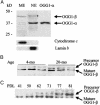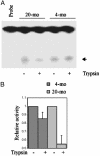Age-dependent deficiency in import of mitochondrial DNA glycosylases required for repair of oxidatively damaged bases
- PMID: 12960370
- PMCID: PMC196862
- DOI: 10.1073/pnas.1932854100
Age-dependent deficiency in import of mitochondrial DNA glycosylases required for repair of oxidatively damaged bases
Abstract
The mitochondria are the major source of chronic oxidative stress, which has been implicated in the aging process. Along with other cellular changes, aged cells accumulate mutations in both their nuclear and mitochondrial genomes, and they contain increased amounts of oxidatively damaged mutagenic bases such as 7,8-dihydro-8-oxoguanine, suggesting age-dependent inhibition of its repair. Surprisingly, the level and activity of 8-oxoguanine-DNA glycosylase (OGG1), responsible for repair of 7,8-dihydro-8-oxoguanine, was found to be higher in the liver mitochondrial extract from old rodents than in that from young ones. We addressed this paradox by analyzing OGG1 in the mitochondria of young vs. old mouse livers, as well as in replicating vs. presenescent human fibroblasts. We show here that although the total OGG1 activity is higher in old mitochondria, a large fraction of the enzyme is stuck to the membrane in the precursor form, which could not be translocated to and processed in the mitochondrial matrix. A nearly identical phenomenon was observed with the mitochondrial uracil-DNA glycosylase responsible for repair of mutagenic uracil. These results indicate an age-dependent decline in the mitochondrial import of proteins needed for DNA repair and possibly for other functions.
Figures





Similar articles
-
Age-dependent increase of 8-oxoguanine-, hypoxanthine-, and uracil- DNA glycosylase activities in liver extracts from OXYS rats with inherited overgeneration of free radicals and Wistar rats.Med Sci Monit. 2003 Jan;9(1):BR16-24. Med Sci Monit. 2003. PMID: 12552232
-
Compromised incision of oxidized pyrimidines in liver mitochondria of mice deficient in NTH1 and OGG1 glycosylases.J Biol Chem. 2003 Sep 5;278(36):33701-7. doi: 10.1074/jbc.M301617200. Epub 2003 Jun 22. J Biol Chem. 2003. PMID: 12819227
-
Repair of 8-oxodeoxyguanosine lesions in mitochondrial dna depends on the oxoguanine dna glycosylase (OGG1) gene and 8-oxoguanine accumulates in the mitochondrial dna of OGG1-defective mice.Cancer Res. 2001 Jul 15;61(14):5378-81. Cancer Res. 2001. PMID: 11454679
-
The OGG1 gene encodes a repair enzyme for oxidatively damaged DNA and is involved in human carcinogenesis.Antioxid Redox Signal. 2001 Aug;3(4):597-609. doi: 10.1089/15230860152542952. Antioxid Redox Signal. 2001. PMID: 11554447 Review.
-
Regulation of intracellular localization of human MTH1, OGG1, and MYH proteins for repair of oxidative DNA damage.Prog Nucleic Acid Res Mol Biol. 2001;68:75-94. doi: 10.1016/s0079-6603(01)68091-7. Prog Nucleic Acid Res Mol Biol. 2001. PMID: 11554314 Review.
Cited by
-
Mge1, a nucleotide exchange factor of Hsp70, acts as an oxidative sensor to regulate mitochondrial Hsp70 function.Mol Biol Cell. 2013 Mar;24(6):692-703. doi: 10.1091/mbc.E12-10-0719. Epub 2013 Jan 23. Mol Biol Cell. 2013. PMID: 23345595 Free PMC article.
-
Identification and characterization of mitochondrial abasic (AP)-endonuclease in mammalian cells.Nucleic Acids Res. 2006 Apr 14;34(7):2067-76. doi: 10.1093/nar/gkl177. Print 2006. Nucleic Acids Res. 2006. PMID: 16617147 Free PMC article.
-
Catalytic activity of OGG1 is impaired by Zinc deficiency.DNA Repair (Amst). 2024 Feb;134:103628. doi: 10.1016/j.dnarep.2024.103628. Epub 2024 Jan 10. DNA Repair (Amst). 2024. PMID: 38228016 Free PMC article.
-
Decline of nucleotide excision repair capacity in aging Caenorhabditis elegans.Genome Biol. 2007;8(5):R70. doi: 10.1186/gb-2007-8-5-r70. Genome Biol. 2007. PMID: 17472752 Free PMC article.
-
Increased mitochondrial DNA damage and decreased base excision repair in the auditory cortex of D-galactose-induced aging rats.Mol Biol Rep. 2011 Aug;38(6):3635-42. doi: 10.1007/s11033-010-0476-5. Epub 2010 Nov 21. Mol Biol Rep. 2011. PMID: 21104133
References
-
- Beckman, K. B. & Ames, B. N. (1998) Physiol. Rev. 78, 547–581. - PubMed
-
- Cortopassi, G. A. & Wong, A. (1999) Biochim. Biophys. Acta 1410, 183–193. - PubMed
-
- Sohal, R. S., Mockett, R. J. & Orr, W. C. (2002) Free Radical Biol. Med. 33, 575–586. - PubMed
-
- Kowald, A. & Kirkwood, T. B. (1993) Mutat. Res. 295, 93–103. - PubMed
Publication types
MeSH terms
Substances
Grants and funding
LinkOut - more resources
Full Text Sources
Other Literature Sources
Research Materials

